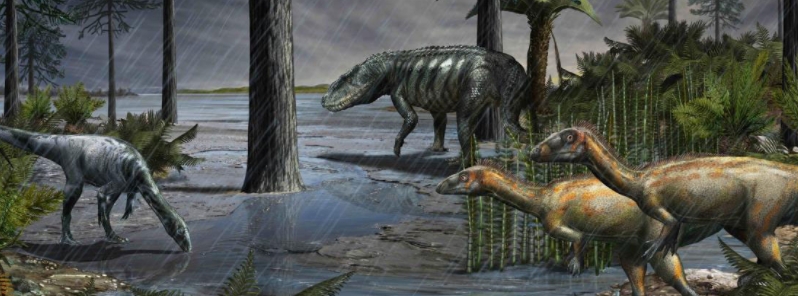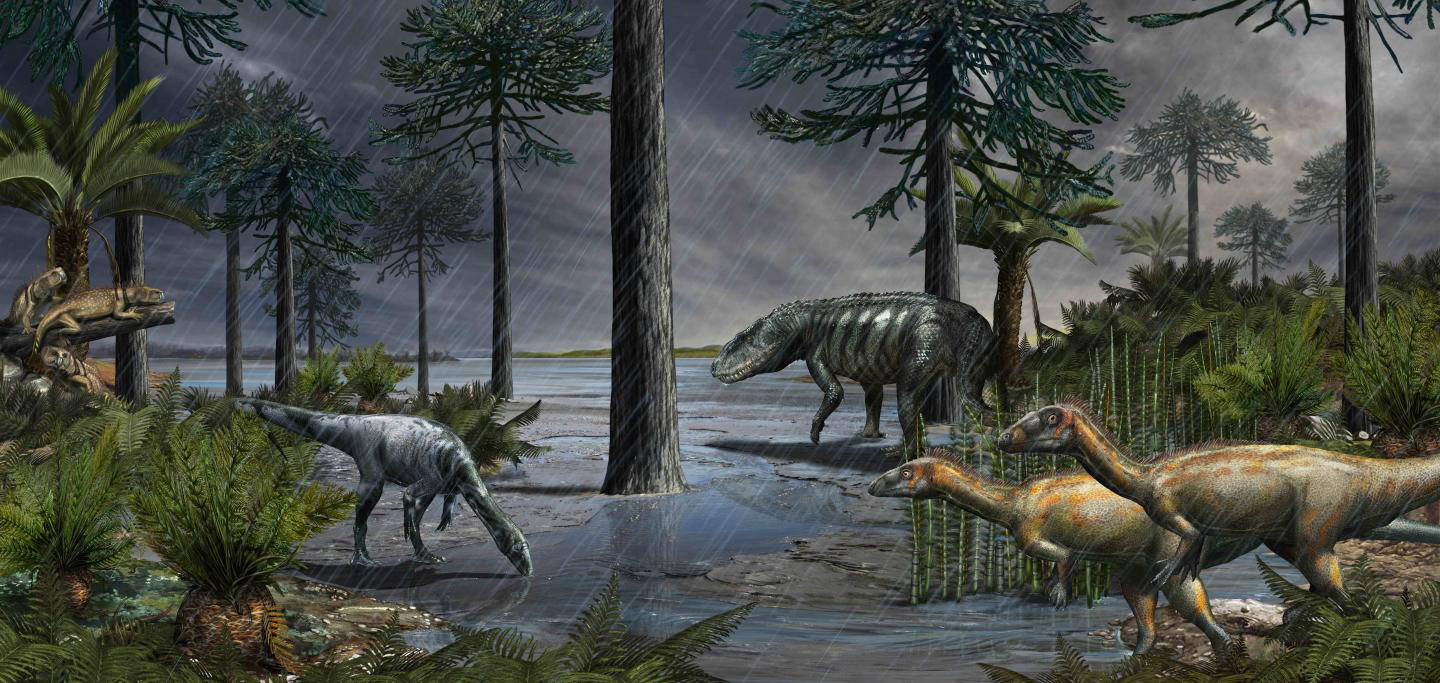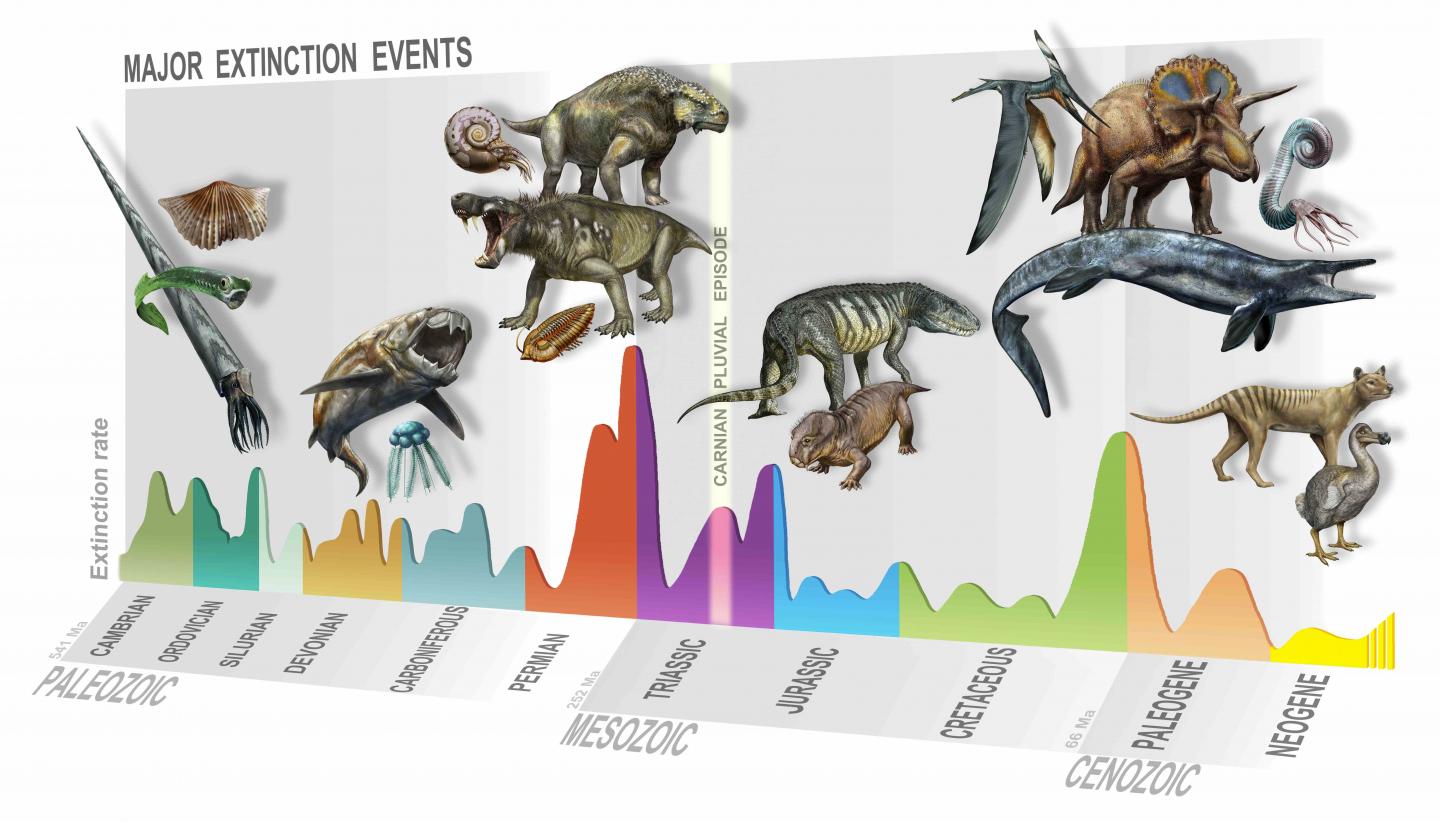Newly identified mass extinction triggered dawn of dinosaurs 233 million years ago

A new study has identified a major mass extinction 233 million years ago, which triggered the dawn of dinosaurs– the event has been called the Carnian Pluvial Episode. During this era, huge volcanic eruptions emitted carbon dioxide, methane, and water vapor into the atmosphere, killing off much of the dominant tetrapods.
The team, composed of 17 researchers led by Jacopo Dal Corso of the China University of Geosciences at Wuhan and Mike Benton of the University of Bristol's School of Earth Sciences, studied all the geological and paleontological evidence, identifying what had happened during the major event.
The Carnian Pluvial Episode was linked to massive volcanic eruptions in the Wrangellia Province of western Canada, where large volumes of volcanic basalt were poured out, forming much of the west coast of North America.
"The eruptions peaked in the Carnian," explained Dal Corso. "I was studying the geochemical signature of the eruptions a few years ago and identified some massive effects on the atmosphere worldwide. The eruptions were so huge, they pumped vast amounts of greenhouse gases like carbon dioxide, and there were spikes of global warming."
The warming was associated with increased rainfall detected back in the 1980s by geologists Mike Simms and Alastair Ruffell as a humid episode that lasted around 1 million years.
The climate change led to major biodiversity loss in the ocean and on land, but after the extinction event, new groups took over and formed more modern-like ecosystems. The changes led to the growth of plant life and the expansion of modern conifer forests.
"The new floras probably provided slim pickings for the surviving herbivorous reptiles," said Benton. "I had noted a floral switch and ecological catastrophe among the herbivores back in 1983 when I completed my Ph.D."
"We now know that dinosaurs originated some 20 million years before this event, but they remained quite rare and unimportant until the Carnian Pluvial Episode hit. It was the sudden arid conditions after the humid episode that gave dinosaurs their chance."

A large Rauisuchia lurks in the background while two species of dinosaurs are shown in the foreground– based on data from the Ischigualasto Formation in Argentina. Image credit: D. Bonadonna/MUSE, Trento
Aside from dinosaurs, many other modern groups of plants and animals also emerged this time, including some of the first species of turtles, crocodiles, lizards, and the first mammals.
The Carnian Pluvial Episode also impacted the ocean life as it marked the start of modern-style coral reefs and many of the modern groups of plankton, indicating profound changes in the ocean chemistry and carbonate cycle.
"So far, paleontologists had identified five 'big' mass extinctions in the past 500 million years of the history of life," Dal Corso noted.
"Each of these had a profound effect on the evolution of the Earth and of life. We have identified another great extinction event, and it evidently had a major role in helping to reset life on land and in the oceans, marking the origins of modern ecosystems."

Summary of major extinction events, highlighting the new one: Carnian Pluvial Episode, 233 million years ago. Image credit: D. Bonadonna/MUSE, Trento
Reference
"Extinction and dawn of the modern world in the Carnian (Late Triassic)" – Dal Corso, J. et al. – Science Advances – DOI: 10.1126/sciadv.aba0099
Abstract
The Carnian Pluvial Episode (Late Triassic) was a time of global environmental changes and possibly substantial coeval volcanism. The extent of the biological turnover in marine and terrestrial ecosystems is not well understood. Here, we present a meta-analysis of fossil data that suggests a substantial reduction in generic and species richness and the disappearance of 33% of marine genera. This crisis triggered major radiations. In the sea, the rise of the first scleractinian reefs and rock-forming calcareous nannofossils points to substantial changes in ocean chemistry. On land, there were major diversifications and originations of conifers, insects, dinosaurs, crocodiles, lizards, turtles, and mammals. Although there is uncertainty on the precise age of some of the recorded biological changes, these observations indicate that the Carnian Pluvial Episode was linked to a major extinction event and might have been the trigger of the spectacular radiation of many key groups that dominate modern ecosystems.
Featured image credit: D. Bonadonna/MUSE, Trento

Theories, speculation, guesses and wild imaginings from unintelligent fake science gods – whose shockingly low IQ’s are uploaded by Psychologists – are contradicted by thousands of other independent sources from all across our Earth which includes hundreds and hundreds of historic documents written by our ancestors who tell us – in over a dozen different languages – the timeline for our continents, oceans, mountains, cataclysms, etc. – they tell us when and how our tectonic plates were broken and subducted, when and how our ocean trenches and archipelago islands were formed, they tell us the history of Antarctica, etc. Collectively, they tell us geologists and glaciologists have it all wrong – our ancestors tell us the ice ages are fiction, Pangaea is fiction, continental drift and continental collision is fiction, etc. They tell us the timeline from carbon dating, ice cores and Egyptology is intentional disinfo – they tell us “scientific” labs are dirty business. Our ancestors also tell us the geological timeline of millions and billions of years is a psy-op, the historical timeline of thousands and thousands of years is a psy-op and the fake biblical timeline of nearly 6,000 years is a psy-op. Those that enjoy theories are free to live their life of lies and lunacy – those who love truth can study the thousands of independent sources from all across our Earth – the choice is yours.
All you have to do is look back to 1815 and Mount Tambora to see that large volcanic eruptions cause cold weather, crop loss, and famine. Tambora created a year without a summer in 1816 and was no major land-forming event as described in the article.
Giant volcanic explosions cause cold weather and crop loss. Mt. Tambora created a year without a summer, and it was no massive land-forming event.
Massive volcanic explosions that would blot out the sun caused huge amounts of warming. It will be difficult to take your site seriously after this mess.
That’s not correct.